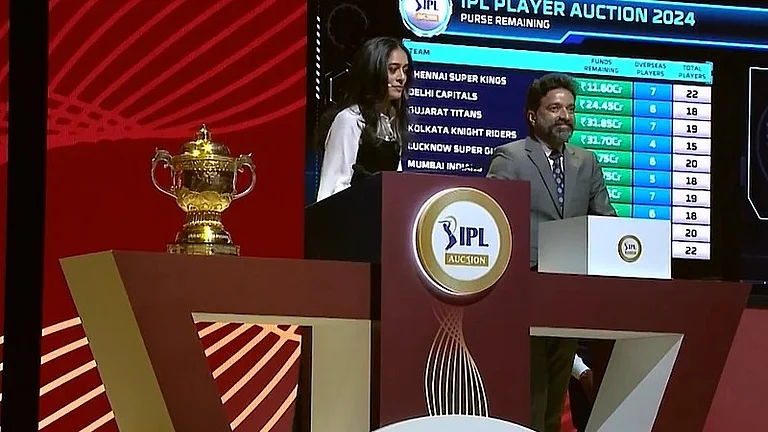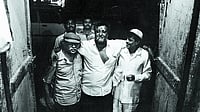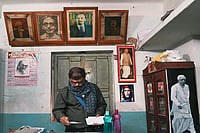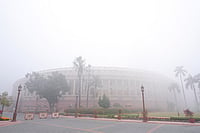‘Factionists’ have been in existence since the days of the Vijayanagara kingdom (16 and 17c), which had a decentralised army and encouraged the local landed elites to maintain private armies and manage revenue collection. Known as ‘palegallu’ in Telugu, the British pronounced them ‘poligars’ and tried to rein them in. But in vain. In 2004, Naidu, the techno-savvy CEO with Vision 2020, actively encourages and draws sustenance from this feudal mafia, perhaps more than Krishnadevaraya in 1520.
The turf lords run a parallel administration in the drought-prone, backward districts of Kurnool, Anantapur, Cuddapah and Chittoor—the ‘faction zones’.
And now is the time that the activities of these ‘factions’ are peaking. M. Bhooma Nagi Reddy, TDP MP from Nandyal, poses at his palatial Allagadda bungalow with his Mitsubishi Lancer that doesn’t bear a registration number. Both he and his wife Shoba Nagi Reddy, a TDP MLA who heads the AP State Road Transport Corporation, are expecting a renomination. With more than 15 registered cases—a couple of them pending trial in a Nandyal court—against him, fief baron Nagi Reddy is eminently qualified in Naidu’s reckoning. Bhooma’s traditional rivals, Gangula Prabhakar Reddy and Gangula Pratapa Reddy, are currently with the BJP, but might switch over to their parent Congress if assured of tickets. The factions—a typical instance of a pre-modern, pre-national social order adapting to the requirements of a modern democracy—don’t mind doing business with any and every party. This feudal vestige is a variation on the familiar lobby politics theme and the resemblance with the caste armies and gangs of Bihar and UP is too close to be missed. "No party in Rayalseema can do politics sans the factionists. Earlier, the Congress was full of them; today the TDP boasts of several. Even the CPI and CPI(M) are not faction-free. If the BJP emerges stronger this time, it too will have its share of factionists," says Kurnool’s human rights activist A. Japanya.
Another faction leader whom Naidu has nursed is Paritala Ravi of Anantapur. Says civil rights activist K. Balagopal: "Without Ravi, Naidu can’t do politics in Anantapur." Ravi, an MLA, is among the several factionists who terrorised Larsen & Toubro with extortion when they set up a cement factory in Tadipatri. He’s an accused in three murder cases, including the deaths of Congress factionists Obul Reddy and S.V. Ramana Reddy. Ravi survived a murder attempt in Hyderabad in ’97: a car-bomb blast at a film muhurat that killed 24 people. Naidu, though, has stood by him.
For the lords, the interests of their factions are paramount, not the political parties they represent. K.E. Krishnamurthy, MP from Kurnool, was in and out of the Congress till he joined the TDP and was victorious against K. Vijayabhaskar Reddy. After the latter’s recent death, the KE group reigns supreme though Vijayabhaskar Reddy’s son, Kotla Suryaprakash Reddy, offers some resistance. Naidu respects the strength of the KE faction and has appointed K.E. Prabhakar, Krishnamurthy’s brother, as the minister for irrigation in his cabinet.
Says Balagopal: "Till the ’70s, factionists were limited to villages and talukas. A few post-Emergency generation factionists have come a long way. But there are a few, like the Kotla and the KE factions, who don’t dirty their hands in day-to-day village-level faction fights. They derive their clout by encouraging and protecting their own factionists." With the onset of Panchayati Raj, these Andhra caste lobbies rediscovered the virtues of violence to further their economic and political interests. Observes Balagopal: "The focus was on controlling civil contracts and the illicit liquor trade. Initially, local MLAs depended on factionists’ support. But soon, the factionists themselves became MLAs. Today, more than half the MLAs and MPs from Rayalseema are factionists."
Village-level turf lords continue to thrive, P. Venkatappa Naidu of TDP being a classic example. The strongman of Kappatrala, 55 km from Kurnool, is loyal to the KE faction. In March 2001, Venkatappa was attacked by members of the rival Kotla faction, but survived. His supporters retaliated and murdered six of the assailants. The multiple murders sparked a debate in the assembly and a house committee was constituted to study faction killings. G.S.S. Shivaji, a TDP MLA who headed the 18-member committee, recently submitted the report—but this was not discussed. Says E. Venkatramana, who runs a provision store in the village: "Kappatrala is like a volcano. The elections could provide the trigger."
Anyone who resists the factions faces death, like Birusanti Obanna, a Dalit leader in the notorious Koilakuntla area of Kurnool district. Obanna was instrumental in the reopening of a stones factory belonging to the Dalits closed down by the factionists in the late ’90s; he had enabled a Dalit, Mala Chenchanna, to reclaim one acre of land occupied by local factionist Manchala Tulasi Reddy; and, most recently, he managed to wrest for a widow five acres of land she had been cheated of by the factionists. Obanna’s recourse to the democratic route reportedly upset TDP’s Tulasi Reddy and led to the former’s murder on January 20 with the alleged connivance of Karra Subba Reddy, former TDP MLA from Koilakuntla. Says K. Satyanarayana, state convenor of Kula Nirmoolana Porata Samiti of which Obanna was a member: "In the faction zone, there’s no space for democracy. Naidu harps on Naxal violence, but factionist violence goes unnoticed."
Telugu cinema has cashed in on the phenomenon. Rayalseema Reddys, and sometimes Naidus, mouth lines like "Kanti chooputo champesta (I’ll murder you with my gaze)" on the screen. The success of Anthapuram in ’98 spawned a spate of movies. NTR’s son N. Balakrishna starred in three hits: Samarasimha Reddy, Narasimha Naidu, Chenna Kesava Reddy. Junior NTR starred in Aadhi, while politician-turned-actor N. Harikrishna, another NTR son, played the tough cop controlling faction violence in Seetayya. Mohan Babu’s Rayalseema Ramanna Chowdhary, Chiranjeevi’s Indra, Rajasekhara’s Bharatasimha Reddy and a love story like Prema Sandadi are other notable faction films.
Till the mid-’90s, factionists moved around in convoys, flaunting guns, traditional weapons and country-made bombs. The gun licences were withdrawn but factionists continue to access arms and explosives. A. Sivanarayana, IG, Rayalseema, points out that faction murders that averaged a hundred per year between ’94 and ’98, came down to 37 in ’99, and nine in ’03. However, the number of firearms and explosives seized in the faction zone has shown a dangerous increase. From 2,640 units raided in ’93, 5,623 in ’95, it shot up to 2,64,120 units in ’02 and 1,90,322 in ’03. While the catch in country-made firearms and explosives shows a downward trend, the use of grenades, detonators, gelatin sticks and bomb-making material has increased over the past 10 years. And the elections might just provide an opportunity to use them.


























